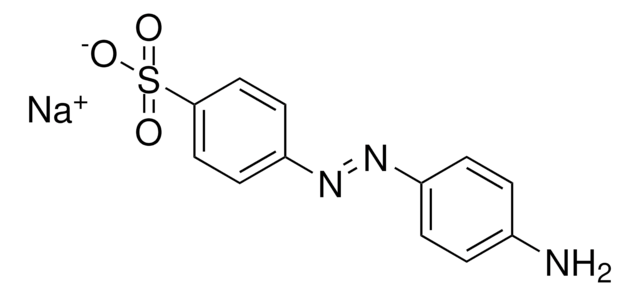919233
Sodium 2-(4-hexylphenyl)diazene-1-sulfonate
(0.5% solution in 25mM aqueous ammonium bicarbonate, pH 7.0), ≥95%
Synonyme(s) :
4-Hexylphenylazosulfonate, Azo
Se connecterpour consulter vos tarifs contractuels et ceux de votre entreprise/organisme
About This Item
Formule empirique (notation de Hill):
C12H17N2O3S · Na
Numéro CAS:
Poids moléculaire :
292.33
Code UNSPSC :
12161503
Nomenclature NACRES :
NA.22
Produits recommandés
Niveau de qualité
Pureté
≥95%
Forme
liquid
Indice de réfraction
n/D 1.334
Densité
0.994 g/mL
Température de stockage
2-8°C
Application
4-Hexylphenylazosulfonate (Azo) is a photocleavable anionic surfactant developed by the Ge lab for use in high-throughput top-down and bottom-up proteomics by mass spectrometry (MS). Initially, the reagent showed a breakthrough as an improved method for top-down analysis [Brown et al. 2019]. Top-down analysis looks at intact proteins, while bottom-up analysis uses digested proteins. Of the two, top-down analysis is preferable for detecting post-translational modifications and sequence variations. Bottom-up is more commonly used and is likely to detect more proteins. This reagent was also shown to work for sample extraction that can be used for both top-down and bottom-up analysis on the same sample to maximize data collection[Brown et al. 2020].
Surfactants are required for protein extraction especially for challenging classes of protein including membrane proteins[Brown et al. 2020] and extracellular matrix proteins[Knott et al. 2020], but surfactants suppress the signal in MS. While removing a surfactant will improve the signal, this can cause protein loss and degradation. Azo allows for easy removal since it can be rapidly degraded using ultraviolet irradiation (λmax = 305 nm). Using Azo in this way reduces protein loss and gives an improved signal. Please see the Ge lab publications for information on using this product [Brown et al. 2019, Brown et al. 2020, Knott et al. 2020, and Aballo et al. 2021].
Product can be used with our line of photoreactors: Including Penn PhD (Z744035) & SynLED 2.0 (Z744080)
Surfactants are required for protein extraction especially for challenging classes of protein including membrane proteins[Brown et al. 2020] and extracellular matrix proteins[Knott et al. 2020], but surfactants suppress the signal in MS. While removing a surfactant will improve the signal, this can cause protein loss and degradation. Azo allows for easy removal since it can be rapidly degraded using ultraviolet irradiation (λmax = 305 nm). Using Azo in this way reduces protein loss and gives an improved signal. Please see the Ge lab publications for information on using this product [Brown et al. 2019, Brown et al. 2020, Knott et al. 2020, and Aballo et al. 2021].
Product can be used with our line of photoreactors: Including Penn PhD (Z744035) & SynLED 2.0 (Z744080)
Informations légales
PCT/US2019/035447
Code de la classe de stockage
10 - Combustible liquids
Classe de danger pour l'eau (WGK)
WGK 2
Faites votre choix parmi les versions les plus récentes :
Certificats d'analyse (COA)
Lot/Batch Number
Désolés, nous n'avons pas de COA pour ce produit disponible en ligne pour le moment.
Si vous avez besoin d'assistance, veuillez contacter Service Clients
Déjà en possession de ce produit ?
Retrouvez la documentation relative aux produits que vous avez récemment achetés dans la Bibliothèque de documents.
Photocleavable Surfactant-Enabled Extracellular Matrix Proteomics.
Knott S J, et al.
Analytical Chemistry, 92(24), 15693-15698 (2020)
Kyle A Brown et al.
Nature methods, 16(5), 417-420 (2019-04-17)
We report the identification of a photocleavable anionic surfactant, 4-hexylphenylazosulfonate (Azo), which can be rapidly degraded by ultraviolet irradiation, for top-down proteomics. Azo can effectively solubilize proteins with performance comparable to that of sodium dodecyl sulfate (SDS) and is compatible
Notre équipe de scientifiques dispose d'une expérience dans tous les secteurs de la recherche, notamment en sciences de la vie, science des matériaux, synthèse chimique, chromatographie, analyse et dans de nombreux autres domaines..
Contacter notre Service technique






